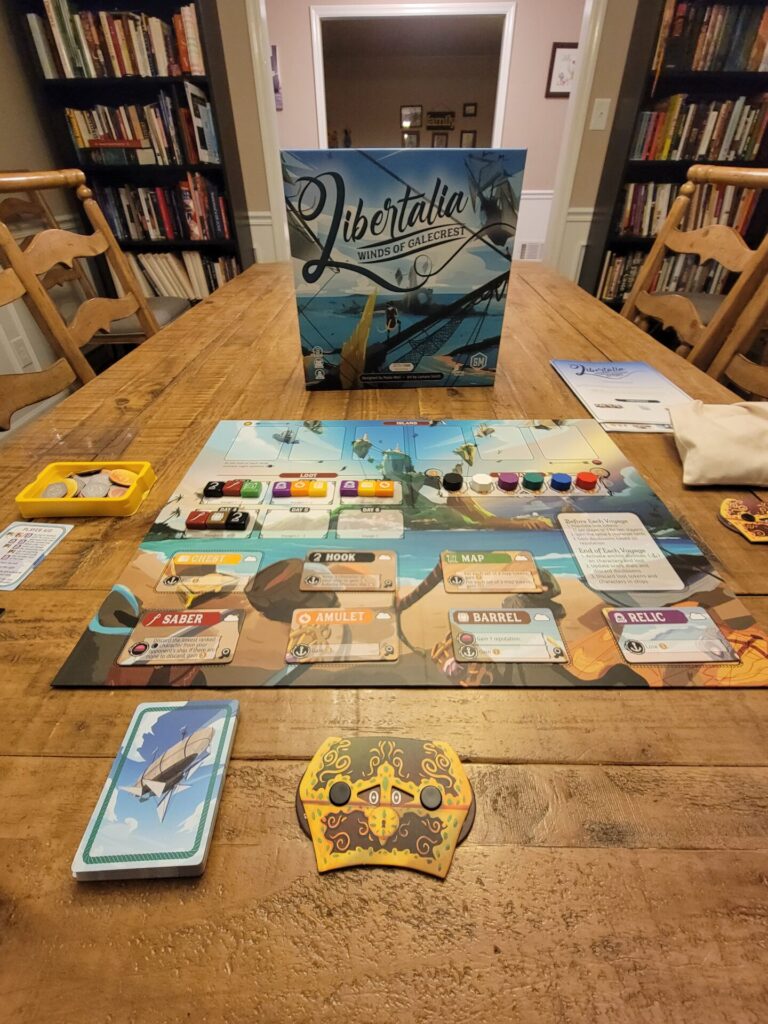
Name: Libertalia – Winds of Galecrest
Year of Release: 2022
Player Count: 1 – 6 Players
Playing Time: 45 – 60 minutes
Designer: Paolo Mori
Publisher: Stonemaier Games
Primary Mechanisms: Action Queue, Hand Management, Set Collection, Simultaneous Action Selection
Weight (According to boardgamegeek.com): 2.12
Overview
Two things you need to know right off the rip:
First, if you somehow missed the title of this review, I will only be discussing the official solitaire version where you play against two artificial players. The main reason I made this decision was that as of the time of this writing, I’ve only played the solo version and the 2-player variant and honestly, the 2-player variant leaves a little to be desired. My wife and I both feel that with more players, it would be incredible but at a count of two, it feels a little lackluster. With that being said, I am tremendously happy with how the designers have set up the Automa to work and think that it deserves its own discussion.
Secondly, I have never played the original “traditional pirate” themed Libertalia, published by Asmodee in 2012. I have no opinions on how the original version stacks up to the newly printed Winds of Galecrest version. If that is what you came here hoping to read, feel free to exit to the left. However, if you feel a yearning in your soul to hop aboard a gleaming airship, surrounded by an anthropomorphic animal crew, setting their eyes on priceless treasures, then read on, you salty, sea (air?) dog!
Rulebook & Components
If you’ve played any games published by Stonemaier Games in the past few years, I’m sure you’ve seen them implement solitaire rules created by the Automa Factory. As with many of these games, Libertalia: Winds of Galecrest (henceforth abbreviated as solely Libertalia), comes equipped with a supplemental Automa rulebook. This rulebook lays out the rule changes between the normal version and the solitaire variant while also supplying the user with a plethora of examples on how the Automa operates. It seems they wanted to keep this rulebook (and the standard one, for that matter) on the slim side but I do think it would have been helpful to have an index of the 40 cards and specific examples of how they work in the solitaire arena. There is one call out for card number 26 (the Cook) to help players understand how to use it verse the Automa but I think it would have been helpful to heave this same level clarification for all the more complex cards. There has been a handful of times where I needed to visit an online forum to get clarification and I would always rather be able to stick to the rulebook for things of this nature.
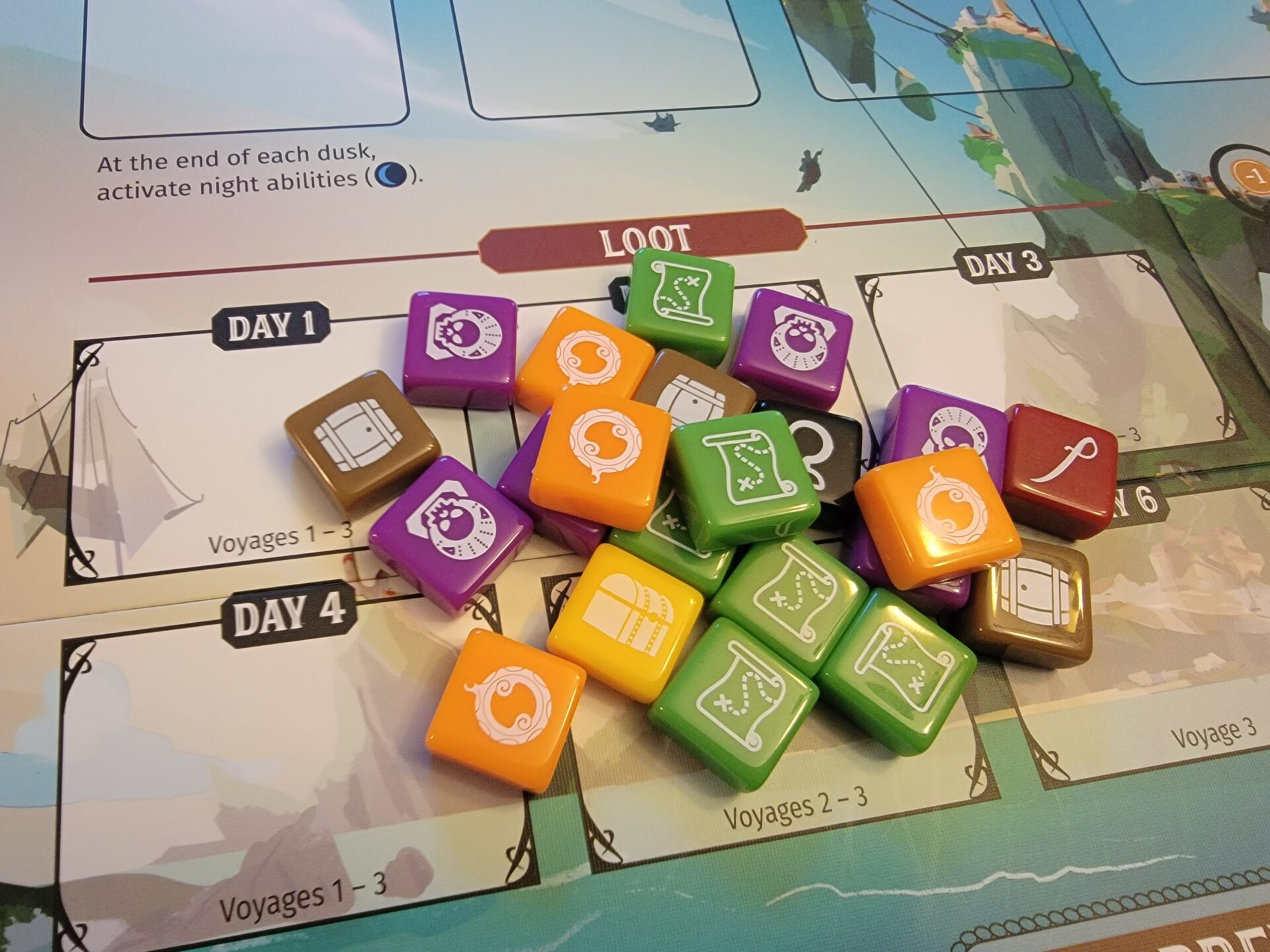
Components seem to be one of the strong points of any Stonemaier game and Libertalia is no different. First, let’s talk about the Loot Tokens, which remind me instantly of the Azul tiles. They are nice and chunky and come in a variety of bright colors, making them stand out on the board. The Loot Tokens pair with seven different Loot Tiles that can be placed over the printed tiles on the board to switch up the scoring conditions of each Loot Token. This modular aspect is really nice and adds a lot of replay value, especially when coupled with the double-sided board that can either be used for a Calm game or a Stormy game. Speaking of the board, it is bright and has plenty of reminders on how a turn and/or round progresses so you’re not constantly grabbing for the rulebook when you come to the game for the first time. While I don’t mind the look and layout of the board, it probably is too big for what its main function is which is really just to have a place to hold the Island cards and tell you what each Loot Token does. There is a time in each round where you will remove your card from the Island and place it on your Ship but the Ship is strictly just the area of the table in front of you. I would have liked to see the community board be slightly more space efficient and have each player get an individual Ship board to hold these cards. Not a huge deal but it would keep the solitaire variant a little more organized, but we’ll get into that more later.
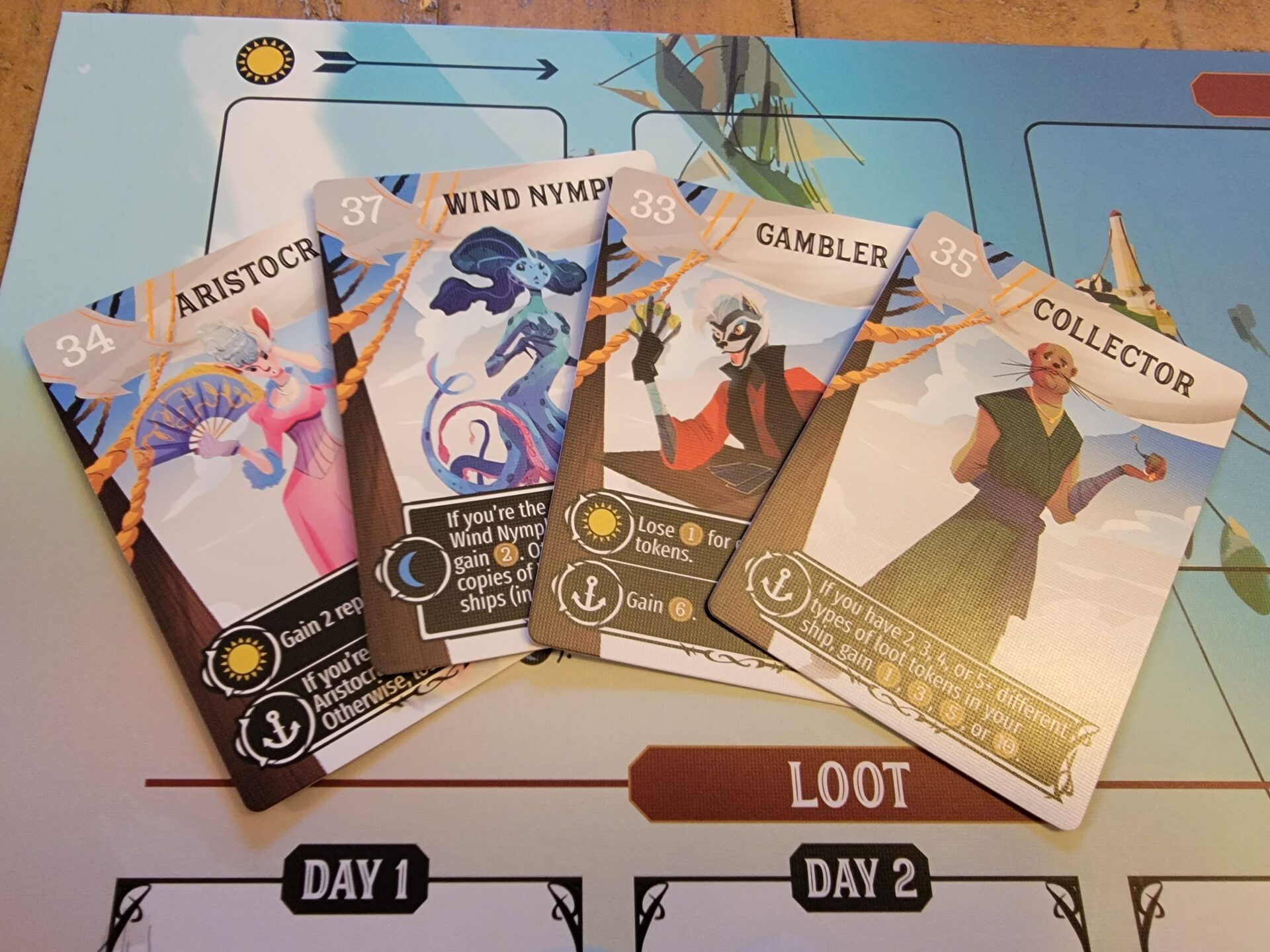
The other component you get plenty of is your deck of Character Cards. Each player color (six in all) has their own deck of 40 characters and then the two artificial players share a single deck in the Automa version. The cards each contain one beautifully rendered character by artist Lamaro Smith, as well as some intuitive iconography. The characters range from types you would normally expect on a sea vessel (Cabin Boy, Quartermaster, First Mate, and Captain) to some more interesting choices (Necromancer, Witch, Collector, and Preacher.) Personally, I love the choice of using humanoid animals as the crews for these massive airships but I see how some would rather have the rough-and-tumble artwork of a traditional pirate crew. The rest of the components are fairly average. You get some cool treasure chest spinners to keep score though I don’t exactly know the best way to fit them into the box as they are slightly wider than the cavity for the deck of cards. If you don’t put them there, they end up going into one of the larger cavities and just sort of flop around. The Dubloons are your normal style money chits that you’ve seen a hundred times before so nothing special there. Lastly, each player is also given a Reputation Tracker in their color. These are chunky, octagonal pieces that much like the board, probably didn’t need to be as big as they are but it’s not a big deal. It would have been nice for them to not just be a large octagon but had a little more character and style to them, but whatever.
Set Up
I recently reviewed Caper: Europe and made mention that it was one of the quickest games to set up. Though it is quick, I think Libertalia has even beat it by a few minutes in both the standard version and the Automa. Set up is probably at five minutes or less. I do want to state the caveat that to make it as quick as possible, you do need to spend a small amount of time during tear down, re-ordering the decks of cards used by the player, but the Automa deck can simply be put away as is and never be re-ordered! The player sets out the board and lays the Automa Loot Tiles in the order as shown in the Automa rulebook. The rules recommend you lay them out in a certain order as it will help you identify the Automa’s Loot priority but once you know the priority after a few plays, you could theoretically place the Loot Tiles out in any order.
Next, you draw out three Loot Tokens from the bag and place them on the space labeled Day 1. You will continue to put out three Loot Tokens on days 2 through 4 for the first voyage. Then you fill up the Reputation Track with all the Reputation Tokens except your color and purple (which Automa always plays as), leaving the third and fourth (from the left) spots open. You randomly choose between your token and the purple token and the one chosen is put in the right-most empty space with the other token taking the last empty spot. Each spot has a number of Dubloons listed under it and you will give out the specific amounts to yourself and the Automa to start the game.
Lastly, you will take the Automa deck and shuffle it up, placing it in a face-down stack. You will draw the top six cards and place them in ascending order, with the purple flag oriented in the top left corner of the cards. You will notice that the bottom of the cards is a mirrored image but without any iconography and with an orange flag instead of a purple one. These are used when it is the Pilferer’s turn but we’ll get to that later. The player will go through their deck and find the exact same six cards that the Automa drew, and this will be their starting hand. With all this being completed, it’s time to set sail and see if you can become the richest sky pirate over the course of three voyages!
Gameplay
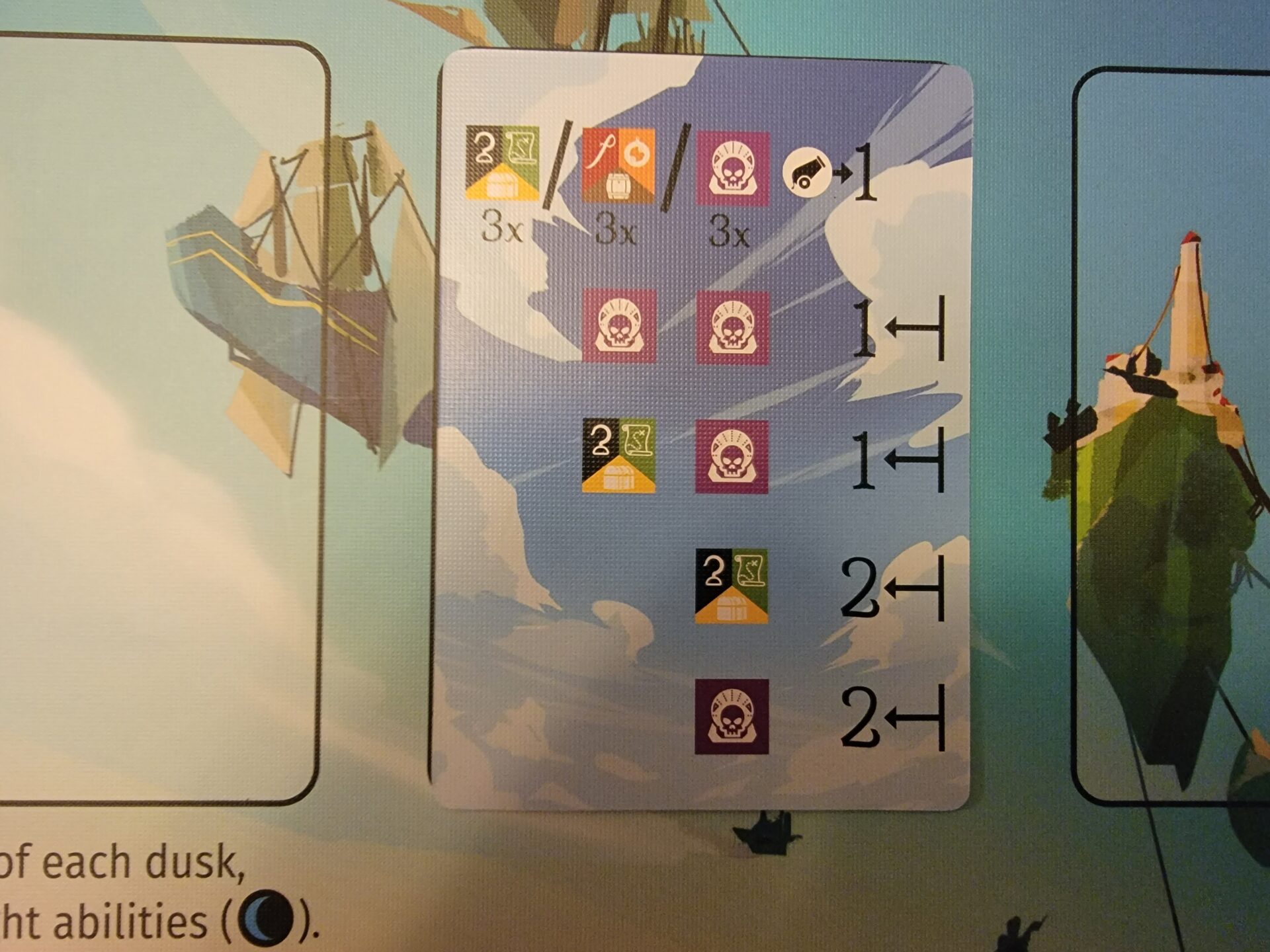
Libertalia’s gameplay in the standard version is meant to be smooth and efficient, with its smart implementation of simultaneous actions, but as I stated earlier, it might be a little too smooth at 2-players. You almost feel like your turn is over before you ever even took it. In the solitaire version, this is alleviated somewhat by handling both artificial players, and I think gives the game just the right pace. The major gist of the game is everyone is choosing a card and placing it facedown at the same time. Once done, all the cards are flipped and the cards are placed in ascending order on the Island. First, any Daytime actions are triggered, moving from left to right down the Island. The actions vary by character but are typically some variation of “If this is the leftmost character on the island, gain three Dubloons” or “Discard a Brawler from an opponent’s ship. If you do, gain 2 reputation.” Once all Daytime actions have triggered, you will move back through the cards, this time from right to left, triggering all Dusk actions. Along with triggering the Dusk action, players will also take one Loot Token from the current day when it is their turn. Which ever cards are left on the Island after this phase, move to their player’s Ship and then Night actions trigger. Play continues like this through each day and then at the end of the voyage, all Anchor abilities on cards in your ship trigger as well as Loot Tokens being turned in for Dubloons or Reputation. Three voyages get completed (each with one more day being added) and then the game is over and most Dubloons wins. A solo game can be played in around 30 minutes for those who have experience with the game.
So, how does the Automa handle all of this? First, the player is always going to choose their card first and place it on the Island. Next, the top card of the Automa deck is going to be flipped and placed on the Island with the orange flag oriented upward to show it is a card played by the Pilferer player. This is an interesting mechanism as it serves two purposes. The first is that the Pilferer is not limited by the six cards drawn by yourself and the Automa, in fact, it can’t even play those as they are already in the Automa’s hand. This adds a bit of chaos as you’ll never know the range of cards that could come out on the Pilferer’s turn. The second purpose is that the icons on the back of each Automa card control which card the Automa will play from their hand to the Island. By having to play the Pilferer card first, you are not able to see the back of the card underneath so you don’t have any hint of what the Automa player is going to pick.
Earlier, I mentioned that the rulebook has you lay out the Loot Tiles in a certain order which helps you remember the three tiers of loot in the solitaire game. Chest, Hook, and Map tokens are considered part of the Good tier. Saber, Amulet, and Barrel tokens are considered part of the Average tier. Relic tokens are the sole inhabitant of the Bad tier. Players will look at the three tokens on the current day and split them into these three categories and then compare that to the back of the next Automa card in the deck. Depending on what Look Tokens are (all three are in same category, there is one good and one bad token, there is at least one good and no bad tokens, etc.) you’ll find that row on the back of the card and it will direct you which card in the Automa’s row to play to the Island. It is set up so that if there are numerous bad tokens, the Automa will attempt to play its highest number cards so that it can secure a choice of Loot first, hoping it doesn’t get stuck with the Relic tokens.
Once this card is placed on the Island, the player will order them in ascending order and then a turn plays out much like the standard version, going from Daytime actions, through Dusk actions and choosing the Loot Tokens, and then finally to the Night actions on the ship. The Automa has a hierarchy of Loot Tokens that will control how it chooses but is sometimes altered depending on what cards it has played. Obviously, some of the actions on the cards in the Automa deck are slightly different from the standard cards so that they work in a solo setting but they are only altered as much as they need to keep them balanced. To me, keeping the Automa deck organized on the table is the only portion of the solitaire version that I think could have been handled better. I mentioned the need for some sort of Ship player board and I got the idea because while playing the Automa, I have realized that I mixed up what card were in its hand and what cards were played to its ship already since they both have to be displayed on the table. This doesn’t really impact the fun of the game but it could have been a small Quality of Life decision that would have improved the solo play.
Conclusion
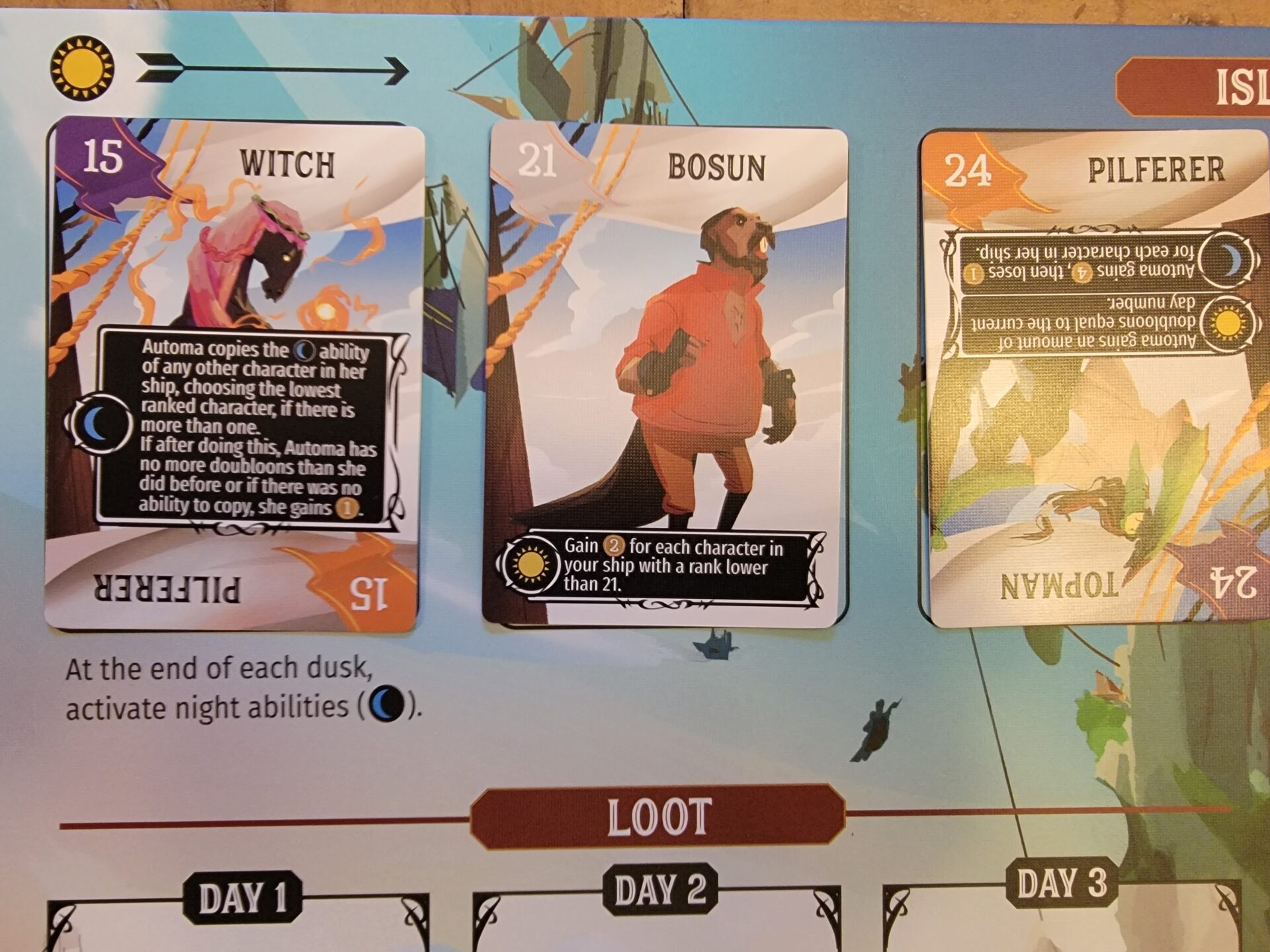
Even though I have always enjoyed the solo variants of Stonemaier games, I didn’t think I’d have so much fun with Libertalia. I think the double-sided board helps in keeping the game from getting stale along with the large pool of character cards. In a typical game, you’ll probably draw 18 cards, so not even half of your total deck. This design decision definitely helps replay value as you’ll have endless combinations of character cards making up your crew each game. While some players might not enjoy another Automa being controlled simply from a deck of cards, I think the Automa in Libertalia is done in a creative fashion that closely mimics playing against real opponents but isn’t so easy that a player can steamroll it every time. And if you are just that good, you can just “up” the difficulty by giving the Automa some more Doubloons to start the game!
If you’re looking for more information on the ins-and-outs of playing the solo version, check out our How To Play video here. Happy sailing, swashbucklers!
Rating
Ratings are based on 5 main criteria: rulebook, setup, components, art & graphic design, and gameplay. The first 4 criteria are rated 1 to 5 and the gameplay is rated 1 to 10. These scores culminate in an “overall satisfaction” score that is rated from 1 to 10. If the reviewed game has both a solo and multiplayer mode, I have assigned scores separately to give context to which mode we enjoy more.
Links
As an Amazon Associate I earn from qualifying purchases.
